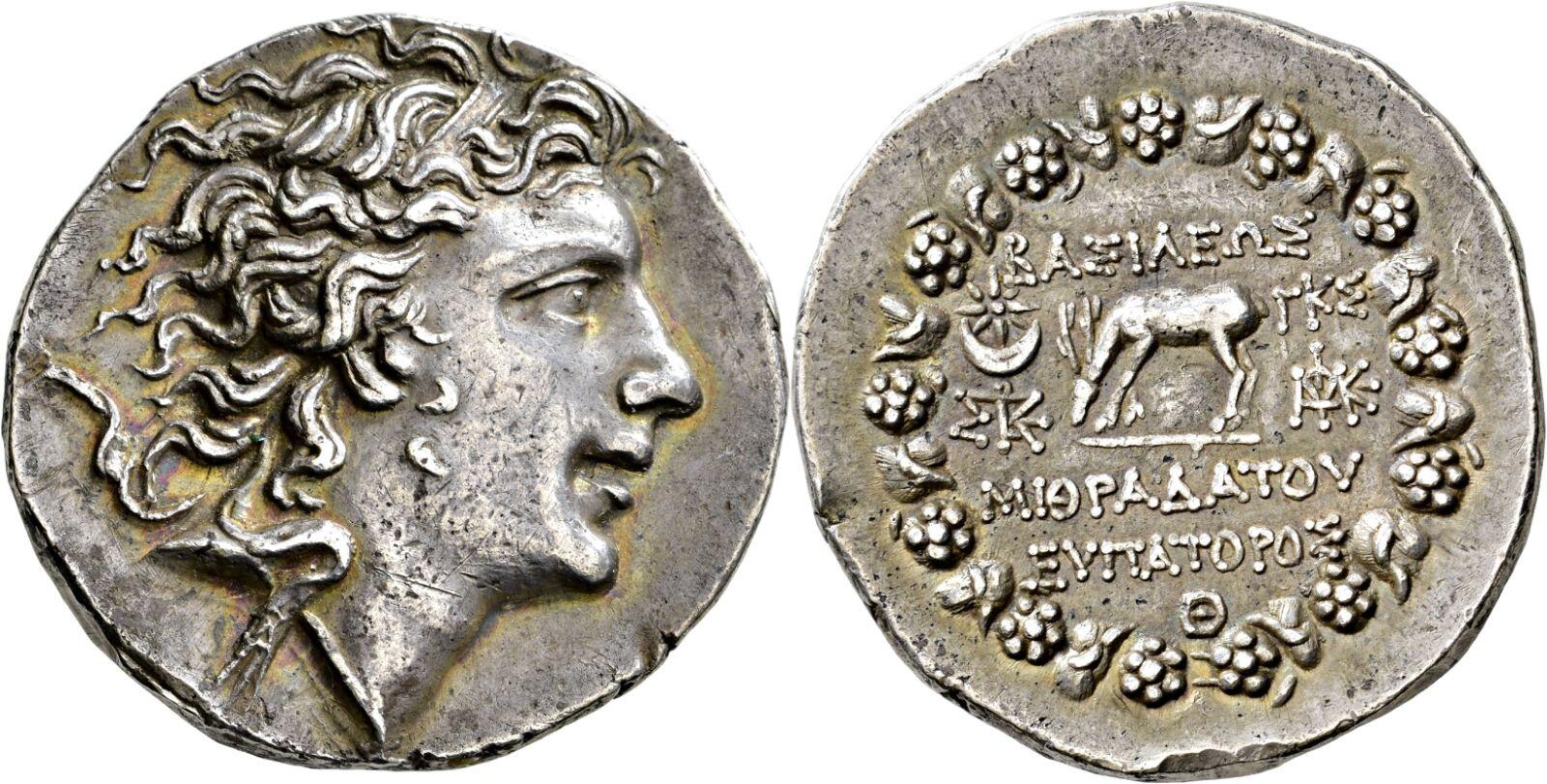Sinope? (Mithridates Eupator), silver, tetradrachms (88-64 BCE)
From SILVER
(No difference)
| |
Revision as of 06:26, 18 October 2022
88 BCE - 64 BCE Silver 37,488 kg
Description
| ObverseInscription or printing placed on the obverse.: | Diademed head of Mithradates VI right, with windswept hair |
| ReverseInscription or printing placed on the reverse.: | ΒΑΣΙΛΕΩΣ ΜΙΘΡΑΔΑΤΟΥ ΕΥΠΑΤΟΡΟΣ (Greek).Stag standing left on ground line, head lowered to graze, star within crescent above, all within ivy wreath |
Mint and issuing power
| MintIdentifies the place of manufacture or issue of a numismatic object.: | Sinope | Ancient regionAncient region.: | Pontus | Modern countryModern country: Turkey | AuthorityIdentifies the issuing power. The authority can be "pretended" when the name or the portrait of X is on the coin but he/she was not the issuing power. It can also be "uncertain" when there is no mention of X on the coin but he/she was the issuing power according to the historical sources: | Mithridates VI Eupator (king of the Pontic kingdom, c. 120-63 BC) |
Chronology
| FromIdentifies the initial date in a range assigned in a numismatic context. | 88 BCE | toIdentifies the final date in a range assigned in a numismatic context.. | 64 BCE | PeriodTime period of the numismatic object.: Hellenistic 323-30 BC |
Physical description
| MetalThe physical material (usually metal) from which an object is made.: | Silver |
DenominationTerm indicating the value of a numismatic object. Examples: tetradrachm, chalkous, denarius.: | Tetradrachm | StandardStandard.: | Attic |
| Mode weightMode of the weights of numismatic objects (in grams).: | 16.70-79<ul><li>No units of measurement were declared for this property.</li> <!--br--><li>"-79" is not declared as a valid unit of measurement for this property.</li></ul> |
Image

H 196 - Uncertain mint (Mithridates Eupator), silver, tetradrachms (88-64 BCE).jpg [1]
References
| Die study referencePublication of the study: | Callataÿ 19971Callataÿ 1997, Callataÿ 20142Callataÿ 2014 | ||
| Coin series referenceReference to coin series study: | |||
Obverse dies distribution
| FrequencyFrequency of specimen in distribution. ᵖ | Number of obversesNumber of obverse dies. ᵖ (o) | % (o) | Number of coinsNumber of coins. (n) | % (n) | Die nameName(s) of the die(s). |
| 1 | 31 | 35.23 | 31 | 11.79 | 2, 6, 7, 9, 13, 14, 15, 16, 17, 19, 20, 25, 31, 35, 36, 40, 41, 44, 51, 64, 68, 69, 71, 72, 73, 74, 76, 78, 3, 8 |
| 2 | 15 | 17.05 | 30 | 11.41 | 22, 26, 29, 43, 47, 50, 55, 58, 59, 63, 65, 75, 77, 1, 4 |
| 3 | 17 | 19.32 | 51 | 19.39 | 1, 8, 10, 11, 12, 21, 23, 24, 28, 33, 38, 42, 45, 46, 57, 66, 70 |
| 4 | 11 | 12.5 | 44 | 16.73 | 30, 32, 39, 53, 54, 60, 62, 67, 2, 5, 7 |
| 5 | 5 | 5.68 | 25 | 9.51 | 4, 18, 37, 56, 6 |
| 6 | 3 | 3.41 | 18 | 6.84 | 27, 49, 52 |
| 8 | 1 | 1.14 | 8 | 3.04 | 61 |
| 10 | 2 | 2.27 | 20 | 7.6 | 5, 34 |
| 12 | 3 | 3.41 | 36 | 13.69 | 3, 48, 1 |
| Total | 88 of 88 | 100.01 | 263 of 263 | 100 |
Reverse dies distribution
no distribution is available
Quantification
| Number of obversesNumber of obverse dies. ᵖ (o) | 88 | Number of singletons (o1)The number of singleton coins. ᵖ | 31 |
| Number of reverse diesNumber of reverse dies. (r) | 191 | Number of coinsNumber of coins. (n) | 263 |
| Coins per obverse dieNumber of coins per obverse die. (n/o) | 2.99 | Coins per reverse dieNumber of coins per reverse die. (n/r) | 1.38 |
| Reverse per obverse ratioRatio of obverse dies divided by reverse dies. (r/o) | 2.17 | Percentage of singletons (o1)number of coins (n) divided by the number of singletons (o1) ᵖ | 35.23 % |
| Original number of dies (O) (Carter 1983 formula)The estimation of the number of coins according to Carter 1983 ᵖ | 112.24 | Coins struck if 20,000 as average productivity per dieCoins made if the average productivity for obverses (according to Carter) is 20,000. ᵖ | 2,244,800 |
| Original number of dies (O) (Esty 2011 formula)The estimation of the number of coins according to the singleton formula in Esty 2011 ᵖ (O) | 132.25 | Survival rate if 20,000 as average productivity per dieSurvival rate if average productivity is 20,000. ᵖ | 0.00012 |
| Coverage (o = % of O) (Esty 1984 formula)Esty 1984 - coverage (% of O) ᵖ (o = % of O) | 88.21% | Die productivity if survival rate 1/2,000Average productivity if survival rate is 1/2,000. ᵖ | 4,686.39 |
| Weight of silver (in kg) if 20,000 coins per die (O = Carter formula)Carter 1983 * Median weight * 20000 (*10 if gold or electrum) ᵖ | 0 kg <br /> 37,488 kg | Die productivity if survival rate 1/5,000Average productivity if survival rate is 1/5,000. ᵖ | 11,715.97 |
Remarks
References
- ^ Callataÿ 1997
- ^ Callataÿ, François de (2014), “Revisiting a numismatic corpus: the case of Eupator, last king of Pontus”, in K. Dörtlük, O. Tekin and R. Boyraz Seyhan (eds.), Proceedings of the First International Congress of the Anatolian Monetary History and Numismatics, 25-28 February 2013 Antalya, Antalya, p. 117-137.